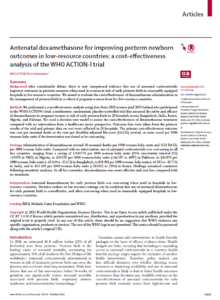
View Resource
Background
After considerable debate, there is now unequivocal evidence that use of antenatal corticosteroids improves outcomes in preterm neonates when used in women at risk of early preterm birth in reasonably equipped hospitals in low-resource countries. We aimed to evaluate the cost-effectiveness of dexamethasone administration in the management of preterm birth in a cohort of pregnant women from five low-resource countries.
Methods
We performed a cost-effectiveness analysis using data from 2828 women (and 3051 babies) who participated in the WHO ACTION-I trial, a multicentre, randomised, placebo-controlled trial that assessed the safety and efficacy of dexamethasone in pregnant women at risk of early preterm birth in 29 hospitals across Bangladesh, India, Kenya, Nigeria, and Pakistan. We used a decision tree model to assess the cost-effectiveness of dexamethasone treatment compared with no intervention from a health-care sector perspective. Outcome data were taken from the primary results of the trial and primary data on cost were collected in 28 hospitals. The primary cost-effectiveness outcome was cost per neonatal death or the cost per disability-adjusted life-years (DALYs) averted, or costs saved per 1000 woman–baby units if the intervention was found to be cost-saving.
Findings
Administration of dexamethasone averted 38 neonatal deaths per 1000 woman–baby units and 1132 DALYs per 1000 woman–baby units. Compared with no intervention, use of antenatal corticosteroids was cost-saving in all five countries, ranging from a saving of US$1778 per 1000 woman–baby units (95% uncertainty interval [UI] –13 878 to 9483) in Nigeria, to $20 531 per 1000 woman–baby units (–46 387 to 4897) in Pakistan, to $36 870 per 1000 woman–baby units (–61 569 to –15 672) in Bangladesh, to $38 303 per 1000 woman–baby units (–64 183 to –10 753) in India, and to $53 681 per 1000 woman–baby units (–113 822 to 2394) in Kenya. Findings remained consistent following sensitivity analyses. In all five countries, dexamethasone was more effective and cost less compared with no treatment.
Interpretation
Antenatal dexamethasone for early preterm birth was cost-saving when used in hospitals in low-resource countries. Decision makers in low-resource settings can be confident that use of antenatal dexamethasone for early preterm birth is cost-effective, and often cost-saving when used in reasonably equipped hospitals in low-resource countries.